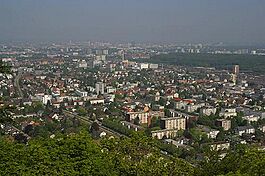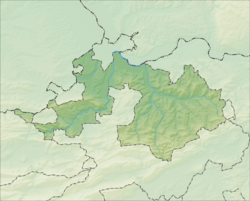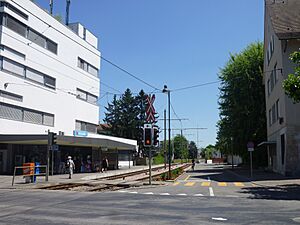Muttenz facts for kids
Quick facts for kids
Muttenz
|
||
|---|---|---|

Muttenz photographed from Wartenberg
|
||
|
||
| Country | Switzerland | |
| Canton | Basel-Landschaft | |
| District | Arlesheim | |
| Area | ||
| • Total | 16.65 km2 (6.43 sq mi) | |
| Elevation | 292 m (958 ft) | |
| Population
(Jun 2021 )
|
||
| • Total | 18,020 | |
| • Density | 1,082.3/km2 (2,803.1/sq mi) | |
| Postal code |
4132
|
|
| Surrounded by | Arlesheim, Birsfelden, Pratteln, Münchenstein, Gempen (Canton of Solothurn), Basel (Canton of Basel-City) and Grenzach-Wyhlen (Germany) | |
Muttenz is a town in Switzerland with about 17,000 people. It's located in the canton of Basel-Country, near the big city of Basel. Muttenz is part of the Arlesheim district.
Contents
History of Muttenz
Long ago, during the Roman Empire, there was a small village here called Montetum. Later, around the 3rd century CE, invaders called the Alamanni renamed it Mittenza.
In the early 800s, the village became part of the bishopric of Strasbourg. Over the next few centuries, different noble families owned the land. Muttenz was first officially mentioned around 1225-1226 as Muttence.
In 1306, the village became the property of the Münch family from Münchenstein. After a huge earthquake in Basel in 1356 damaged their castles on Wartenberg hill, the Münch family made the village church of St. Arbogast stronger with a wall in the early 1400s.
By 1517, the Münch family was having financial problems, so they sold Muttenz and Wartenberg to the city of Basel. After the Protestant Reformation in Basel, the church in Muttenz also became Protestant in 1529.
In 1628, a terrible disease called the plague killed many people in Muttenz. Later, in the mid-1700s, many poor villagers moved to the Americas to find a better life. In 1790, the farmers were finally freed from being tied to the land (serfdom) by Basel's city council. After the French Revolution, they no longer had to pay tithes (a type of tax).
In 1833, after a short civil war, the canton of Basel split into two parts: Basel-City and Basel-Country. Muttenz became part of Basel-Country. It stayed a farming village until the early 1900s, when it started to grow into the industrial town we see today.
Geography of Muttenz
Muttenz covers an area of about 16.64 square kilometers (6.42 square miles). A large part of this land, about 40.6%, is covered by forests. Another 41.2% is used for buildings and roads, making it a developed area. About 16% of the land is used for farming.
The town is located east of Basel, in the Arlesheim district. The older part of the village is nestled between the Rütihard and Wartenberg hills. The newer homes and industrial areas are found along the Rhine river.
Coat of Arms
The coat of arms for Muttenz shows a red castle with three towers on a blue background. From the castle, a red lion with two tails is rising up.
People and Languages
Muttenz has a population of about 17,000 people. Most people in Muttenz speak German. Other languages spoken include Italian language and French.
Many people who live in Muttenz were born there, or in the same canton. Others moved from different parts of Switzerland or from other countries.
The population of Muttenz has grown a lot over the years, especially in the mid-1900s. You can see this growth in the chart below:

Important Historical Sites
Muttenz has several places that are considered important heritage sites for Switzerland. These include:
- The Au-Hard, which was part of the Roman defenses along the Rhine river.
- The Freidorf settlement, a special housing area.
- The Rangierbahnhof (Train Station).
- The Reformed Parish Fortified Church of St. Arbogast.
The entire old village of Muttenz and its cemetery are also listed as important Swiss heritage sites.
Wartenberg Hills
In the Middle Ages, three fortresses were built on the Wartenberg hills. They were badly damaged in the 1356 earthquake but were rebuilt. Later, they were left empty. Some parts were fixed up in the 1950s.
St. Arbogast Church
The fortified church of St. Arbogast was built in the late Middle Ages. It has strong, seven-meter-tall walls built in the 1400s that are still standing. A small building for bones (a charnel house) was added next to the church in the 1400s.
Inside, there were wall paintings from 1513, but they were painted over after the Protestant Reformation. They were uncovered and restored in the 1970s. In 1983, Muttenz won the Wakker Prize for its efforts to preserve its old buildings, including the church. The church and the old village center are both important heritage sites.
Freidorf Settlement
Freidorf is a unique community with 150 buildings. It was built in 1920 by Hannes Meyer, an architect connected to the Bauhaus art school. This settlement is also listed as a national heritage site.
Economy and Jobs
Muttenz has a strong economy with many jobs. People work in different areas:
- Agriculture: A small number of people work in farming.
- Industry: Many people work in factories and manufacturing, making goods. There are also jobs in construction.
- Services: The largest number of jobs are in the service sector. This includes jobs in sales, transportation (moving goods), hotels and restaurants, information technology, finance, science, education, and healthcare.
Many people travel into Muttenz for work, showing it's an important place for jobs in the region. Most people use public transportation or private cars to get to work.
Religion
In Muttenz, many people belong to the Swiss Reformed Church or are Roman Catholic. There are also people who follow other Christian faiths, Islam, Buddhism, and Hinduism. Some people do not belong to any church.
Transportation
Muttenz is well-connected by train. It is on the Bözberg and Hauenstein lines. The Basel S-Bahn (a local train system) also serves Muttenz at the Muttenz railway station.
Education
Many people in Muttenz have completed higher education, either at a university or a specialized college (a Fachhochschule).
Muttenz has several libraries, including the Bibliothek zum Chutz. There are also two libraries at the Muttenz campus of the Fachhochschule Nordwestschweiz, which is a university of applied sciences. These libraries have many books and other media available for people to borrow.
Famous People from Muttenz
- Karl Jauslin (1842–1904): A Swiss painter known for his history paintings.
- Peter Füri (1937–2015): A Swiss football player and manager.
Images for kids
See also
 In Spanish: Muttenz para niños
In Spanish: Muttenz para niños













